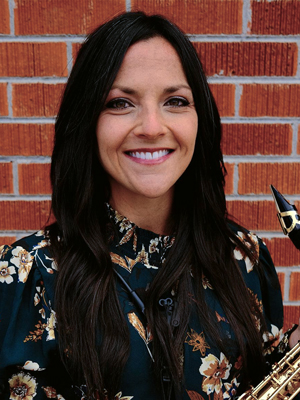Hello!
Wichita State University's School of Music has developed programs in music education,
music performance, pedagogy, history/literature, theory/composition, and conducting
which are significant in size and quality and are highly acclaimed throughout the
nation. In part, this is due to Wichita State's urban setting, affording cultural
diversity with excellent opportunities for faculty and students.
Faculty members in the School of Music are artist-teachers who have significant teaching
and professional playing experience. Each full time faculty member is a nationally
recognized musician in their own right and frequently appear as guest artists, guest
conductors and clinicians throughout Kansas and the United States. Their successful
careers span all facets of the professional world.
Many members of the faculty are principals or members of the Wichita Symphony Orchestra,
as well as members of faculty ensembles and other ensembles of national repute. Faculty
ensembles present a concert on campus each year. In addition, these ensembles frequently
present concerts and clinics at other universities and communities throughout the
nation. The music faculty at Wichita State are committed to each individual student
and are interested in personal music development.
Both individual performance skills and ensemble experience are central to the music
program at Wichita State University. The School of Music offers an excellent variety
of performance opportunities through a wide range of large ensembles, including four
choirs, two concert bands, a symphony orchestra, a jazz ensemble, and athletic bands,
and small ensembles.
Because of the close relationship between the University and the Wichita Symphony
Orchestra, music students are not only able to hear world-class artists perform throughout
the year, but are often given the opportunity to meet and play for them in masterclass
situations.
Graduate Auditions
Please contact the studio professor of your respective instrument (listed above) to
make audition arrangements and schedule a campus visit. That studio professor will
also help determine if a recorded audition would be appropriate.
Bassoon
An on-campus audition is expected but can be substituted by submitting a high-quality
recording (mailed CD or audio files shared via an online platform such as DropBox,
YouTube or SoundCloud). The audition should include:
- Two whole pieces of contrasting styles or different time periods
- One technical etude (Milde scale or arpeggio study, Jancourt etude, Piard scale study,
or others)
- Four excerpts of your choice
Clarinet
An on-campus audition is expected, but can be substituted by submitting a high-quality
recording (mailed CD or audio files shared via an online platform such as DropBox,
YouTube or SoundCloud). If you are applying for the Clarinet Graduate Assistantship
position (GSA), an on-campus visit is required. Live or recorded audition requirements:
- At least one movement of a standard concerto (Mozart, Weber, Nielsen, Copland, Crusell,
Francaix or other work of comparable level)
- Two other contrasting works/movements of your choice, at least one of them composed
during the 20th or 21st century
- Three orchestral excerpts of your choice
Flute
Interested persons are requested to prepare for an on-campus audition:
- Three movements or pieces from the standard repertoire of your choice
- Three to five orchestral excerpts of your choice
Oboe
Interested persons are requested to submit a recent CD recording or mp3 or other up-loadable
sound files of their playing to Professor Banke at the earliest possible date. You
are encouraged to send repertoire you are comfortable with, and that represents your
playing accurately. All recordings should include a variety of solo literature and
orchestral excerpts of candidate's choice. Acceptable materials include but are not
limited to:
- Barret Grand Studies
- Ferling 48 Studies
- Bozza 18 Etudes
- Telemann Partitas
- CPE Bach Sonata; any Bach Sonata or Concerto
- Mozart Oboe Quartet or Concerto in C M
- Hummel Adagio, Theme+Variations
- Bozza Fantasie Italienne
- Poulenc Sonata
- Hindemith Sonata
- Britten Six Metamorphoses
- Telemann Sonatas
- Vivaldi Concerti
- J.S. Bach Sonatas, Concerti
- Pasculli Concerto
- Kalliwoda Concerto
- Strauss Concerto
- Goossens Concerto
- Vaughan-Williams Concerto
- Dutilleux Sonata
Saxophone
To audition for the saxophone studio you must perform either a live, on-campus audition
for Jim Pisano, or submit a professionally-recorded screening recording for consideration.
If you are applying for the Saxophone Graduate Assistantship position, an on-campus
visit is required.
You should select repertoire that you feel best represents your strong suits as a
performer, and music with which you feel comfortable. Although it's expected that
most of your audition repertoire will be played on alto saxophone, applicants may
also play works on soprano, tenor, or baritone saxophones to demonstrate versatility.
Below is a suggestion of repertoire that is expected of incoming graduate students
at Wichita State University.
Etudes: two etudes of contrasting character (one lyrical, one technical). Selections
from the 48 Etudes by Ferling, 18 Etudes after Berbiguier, Neuf Etudes Transcendantes
by Samyn, or 28 Etudes after Messiaen by Lacour are acceptable
Scales: any full-range major and minor scales can be asked at the time of the audition.
Please include three scales of both major and minor (six total) on any audition recording.
Chromatic Scale, full range
Repertoire: a twenty to thirty minute program from the standard repertoire demonstrating
both technical and lyrical abilities. Competitive applicants will want to include
one contemporary work on their program. Acceptable works:
- Concerto by Ingolf Dahl
- Prelude, Cadence, et Finale by Alfred Desenclos
- Concerto by Pierre-Max Dubois
- Concerto by Alexander Glazunov
- Brilliance by Ida Gotkovsky
- Concerto by Karel Husa
- Concertino da Camera by Jacques Ibert
- Neuf Etudes by Christian Lauba
- Mai by Ryo Noda
- Concerto by Henri Tomasi
- Fantasia by Heitor Villa-Lobos
Any other works of comparable quality.














